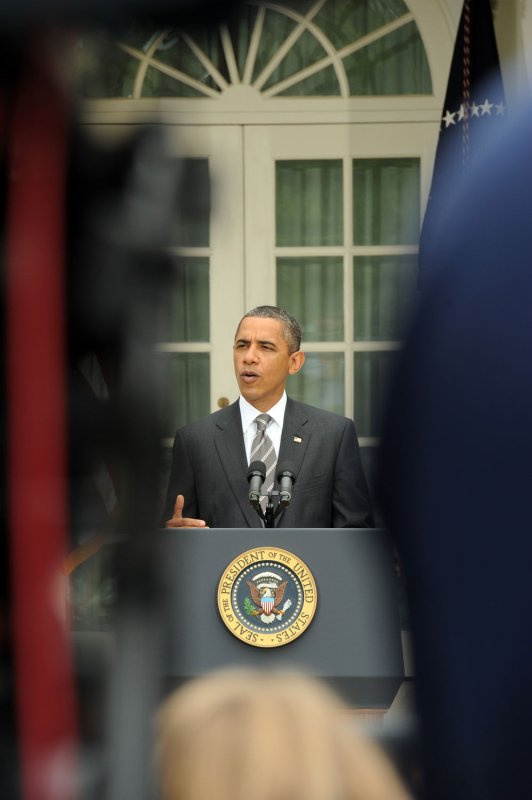U.S. President Barack Obama discusses the June jobs and unemployment numbers in the Rose Garden of the White Housel in Washington, DC, on July 8, 2011. Unemployment rose to 9.2 percent while the economy only added about 18,000 jobs, well below the 100,000 or more that many economists expected. UPI/Roger L. Wollenberg |
License Photo
ZURICH, Switzerland, July 11 (UPI) -- China, the locomotive that has been driving the world economy, is slowing. And since the rest of the world is in no shape to compensate, a second recession or a very prolonged slowdown is starting to look inevitable.
None of the world's other economies looks capable of making up for the boost China has been giving to global growth over the past three years.
Europe remains stuck in a worsening euro currency crisis, with interest rates starting to rise and public spending being cut. The United States dithers and squabbles over its debt ceiling but the central bank is curtailing its support for liquidity. Japan is in recession.
If the world economy were a 4-cylinder automobile, a mechanic would say that one (Chinese) cylinder is still functioning but slowing, two (Europe and the United States) are sputtering and the fourth (Japan) is dead.
A more generous mechanic might say that there are two more cylinders; that the Middle East and Latin America are recording growth. But they are very small by comparison with the others and growth in the Middle East is directly related to the high oil prices that have hurt the bigger economies elsewhere.
China's slowdown is a relative matter. The latest official figures claim that China's imports grew by 19 percent in June, compared with a year ago, a sharp drop from the 28 percent surge in May. Meanwhile exports rose by a smidgeon less than 18 percent, a modest slowdown compared to the nearly 20 percent rise in the previous month.
These figures were disappointing for Chinese analysts but may have been a mild relief for the government. Beijing is seeking to arrange a soft landing for the overheating Chinese economy, now that the latest inflation figures, released Saturday, reached a worrying 6.4 percent.
Put all this together and the outlook for the global economy is grim. We are heading back to where we started in 2008, before some $10 trillion in deficit spending and liquidity creation was pumped into the system. Just more than of this came from central banks like the Fed and the Chinese government ordering its own commercial banks to lend like never before. The remainder came from stimulus packages and deficit spending.
It was an extraordinary tidal wave of money and it probably staved off a new Great Depression but it didn't ignite a real recovery. Even China's surging growth rates of the last two years were not really as impressive as they seem, being based on a flood of over $3 trillion in bank loans. And as Moody's, the ratings agency, warned last week something like $500 billion of these loans (mainly to local governments) look likely to be non-performing.
It is time to dig out yet again those initials that were fashionable in 2009 to try to explain the state we were in. There was the L-shaped recession, in which the economy zoomed downward and then stayed down -- rather like what has happened in Europe (Germany excepted).
Then there was the U-shaped recession, in which the economy zoomed downward, stayed there for a while and then bounced back up. That is what optimists thought was happening to the U.S. economy until the latest gloomy jobless figures and the ongoing housing crisis and the political crisis over the debt ceiling combined to sap consumer confidence.
Then there was the V-shaped recession, in which economic growth plunged, hit bottom and then zoomed back upward again. This is what the Chinese thought was happening, until they remembered that their export-based economy depends on overseas markets with money to import products from China. Those overseas markets are in trouble, so export-led growth no longer looks quite so promising. That is why China's new 5-year plan seeks to increase domestic consumption rather than exports.
It is also why we are starting to hear once again of that other, ominous initial: the W-shaped recession, in which the world economy slumps, bounces back up and then slumps again into a double-dip recession.
So far, such a prediction would be premature. The White House and the U.S. Congress could reach a sensible compromise over tax hikes and spending cuts to fend off the threat of a debt default.
The Europeans could agree to launch a euro-bond that was issued by the EU Commission or by the European Central Bank rather than as now allowing each euro-zone member state to issue its own euro-bond.
This would require a level of political accord and commitment that looks highly unlikely. But with Greece needing more than $50 billion in new funding this month and Portugal's bonds downgraded to junk, the Europeans are being painted into the same corner where the dispirited Japanese now stand. America's dysfunctional political system is steadily shunting them in the same direction.
At least as likely as a double-dip recession is a renewal of the stagflation, depressingly low growth plus stubborn inflation, that we last experienced in the 1970s. Unless some new technological breakthrough emerges in energy supply or in crop yields, few alternatives are in sight.















